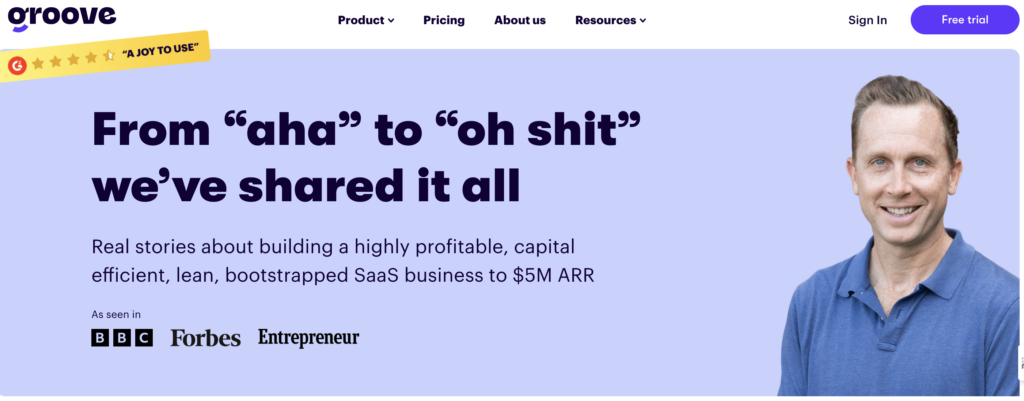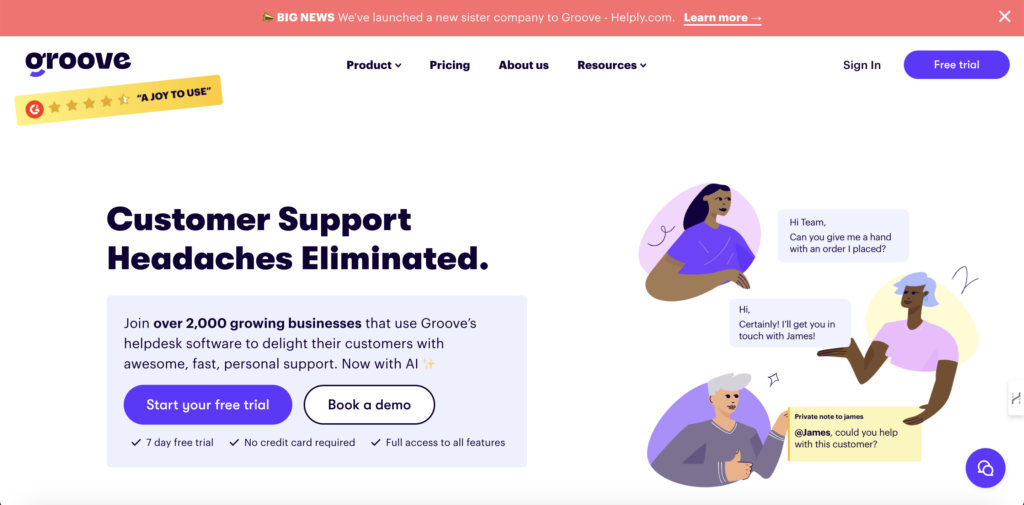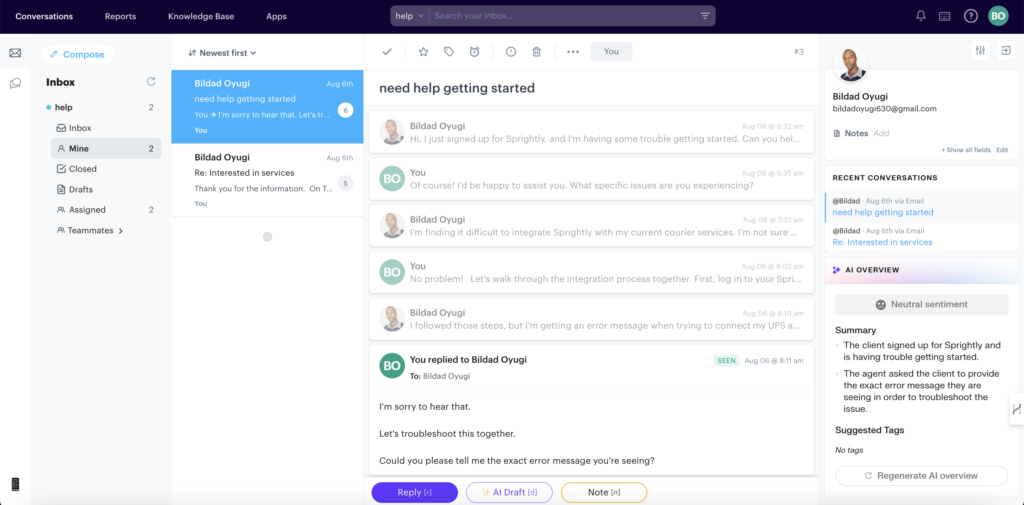You poured your heart and soul into building your dream business. You know you’ve got a fantastic product or service to offer. Yet the big question still looms: how do you get people to actually buy it?
Attracting customers often feels like an uphill battle. That’s especially true when you’re faced with customer acquisition challenges like limited resources, fierce competition, and a constantly evolving digital landscape.
But many startups and small businesses have overcome those obstacles, and so can you! In this post, we’ll arm you with actionable strategies to begin tackling six of the most common challenges to customer acquisition. Taking these steps starts your business down the path to real, sustainable growth.
Challenge #1: Limited Resources (Time, Money, Expertise)
Running a small businesses means doing your best with the resources you have. A small team and budget is a significant constraint that impacts nearly everything you do.
That includes making it more difficult to effectively reach and engage potential buyers. Limited resources pose a variety of tricky customer acquisition challenges:
- Inconsistent marketing efforts. When funds are scarce, maintaining a consistent digital presence is hard. This negatively affects your reach, and slows down the growth of your brand’s reputation and visibility.
- Difficulty scaling campaigns. Expanding your reach with limited resources requires very careful planning and targeting. It’s easy to spend all your budget on a campaign with the wrong messaging or that reaches uninterested audiences. Even if you figure out what went wrong, you may not be able to afford to try again right away.
- Inability to implement new strategies. Resource constraints often mean missing out on marketing strategies that make use of new technology, tools, programs, or outlets. It can also simply mean a lack of the time or expertise required to understand and use novel strategies effectively.
Overcoming Resource Limitations
So how can you consistently bring in new buyers, even with heavy constraints? It’s not an easy task, but here’s what you’ll want to keep in mind:
- Prioritize and focus. Trying to do everything or be everywhere is tempting, but it can spread you too thin very quickly. Instead, identify the marketing channel(s) that give you the best value for your investment, and master them before trying something new.
- This way, you concentrate your efforts where they’ll have the most impact. Are you a B2C cosmetic brand? If you find that most of your audience uses Instagram to discover new products, you can make a lot of progress via targeted outreach on that one platform.
- Embrace cost-effective tactics. Leverage affordable strategies like content marketing and social media to maximize your reach.
- While many marketing channels (such as paid advertising) can be costly, social media is a free and powerful asset. Compelling and carefully branded content bring more visibility without the high price tag.
- Leverage free tools and resources. Many marketing tools offer free tiers. Don’t be afraid to make the most of those before paying for a bigger feature set. If your branding, product, and message is good enough, you don’t need added bells and whistles to have an impact.
- For example, there are plenty of free (or very low cost) email marketing platforms that let you build and nurture an audience. When that audience grows big enough that you need a higher-tier plan, your resources will have grown too!
- Keep a close eye on ROI. Don’t just guess at what’s working (and what’s not). If you’re not tracking ROI, you’re flying blind.
- You can use data tracking tools to make informed decisions and optimize your strategies. There are free options here as well, such as Google Analytics.
Challenge #2: Lack of Brand Awareness
Growing your customer base requires building visibility via brand awareness. Attracting website visitors, generating leads, and building trust with potential customers becomes significantly more challenging if no one knows you exist.
Yet it can be so tempting to focus solely on bringing in conversions. Generating brand awareness takes time and effort, and it may not immediately register. So it’s easy to write off as wasted time, rather than as a valuable investment.
People feel more positively about things they’re more familiar with. Maybe they don’t purchase from your business the first time they encounter it. But after seeing your brand pop up in various ads and social media posts, and landing on a few of your helpful blog articles, they’re a lot more likely to give you a chance.
On the other hand, a lack of brand awareness poses some real challenges to customer acquisition:
- Reduced touchpoints. The fewer interactions your audience has with your brand, the fewer opportunities there are for them to learn about it and convert.
- Less trust. If they aren’t familiar with your brand, they don’t know if you’re trustworthy. You’ve lost the chance to establish your business as an authority and key player in your niche.
- Fewer conversations. The more visible your brand is, the more people will talk about it. This grows awareness even further, creates new content for potential buyers to stumble across, and helps with word-of-mouth sales. If no one is talking about your business, on the other hand, it’s almost like it doesn’t exist.
Overcoming a Lack of Brand Awareness
At a very basic level, the solution to this particular set of customer acquisition challenges is: Spend time building brand awareness!
Of course, that’s not enough. You need to know how to create that awareness effectively, and how to nurture it without pulling too much focus away from more direct conversion-generating strategies.
We recommend starting with the following:
- Define your Unique Value Proposition (UVP). Clearly articulate what makes you stand out from the competition. If you identify the unique benefits you offer, you can better communicate them to your target audience via your website, social media, and other marketing channels.
- Do you offer a faster product? A cheaper service? Are you more focused on the customer than everyone else in your niche?
- Craft a compelling brand story. Facts aren’t enough. To connect with your audience on an emotional level, share your story on your blog, through social media posts, or in interviews. Talk about your brand’s mission, its values, and the ‘why’ behind your business.
- Resources like storytelling workshops and online courses can help you refine your narrative skills. And remember, it doesn’t have to be all positive. Sharing a setback your business experienced can be captivating and relatable.

- Create great content. Create high-quality content that educates, entertains, or inspires your target audience. It gets your business’ name out there, and associates it with authority and value.
- Position yourself as a thought leader in your industry. You can start by identifying the topics your audience cares about, then use platforms like blogs, podcasts, and videos to share your insights.
- Be active on relevant social media platforms. Find out what social sites your target audience already spends time on. Then you can engage in conversations, participate in industry discussions, and build relationships. Polls, Q&A sessions, and live videos can also encourage engagement.
- Don’t expect overnight success. Finally, remember that building brand awareness involves making mistakes, learning from them, testing new strategies, and slowly connecting with your audience. It takes time and patience, but in turn, strong brand awareness tends to ‘stick’.
Challenge #3: Fierce Competition
Just about every online market is saturated with content and advertising. Standing out can seem impossible, especially when you’re up against well-entrenched competitors.
Competition presents challenges to customer acquisition in almost every area. It makes it harder for you to get people’s attention in the first place, and more difficult to convince them to choose you over the alternatives.
You’ll be facing:
- Visibility struggles. It’s challenging to establish and maintain a presence alongside larger competitors. Even your best-constructed messages might get lost in the noise, preventing you from reaching your target audience.
- Credibility concerns. You may face skepticism from potential customers. The prevalence of online scams has made consumers wary. Plus, the sheer amount of choices can be overwhelming and confusing on the buyer’s end. A lot of people will simply stick with familiar, established brands, even if what you’re offering is superior.
- Customer retention issues. Larger competitors with strong brand loyalty and perceived higher value can lure your customers away. This can lock you into a never-ending cycle of desperate (and costly) acquisition campaigns, since you need to constantly attract new buyers now just to survive.
Overcoming Competition
The worst way to deal with competition – especially as a small business – is to face it head-on. Without incredible luck, you’re not going to knock your big, established competitors down any time soon.
Instead, focus on reducing the competition itself by making your business as distinct as possible. You may offer something similar to those other businesses, but you’re not filling exactly the same needs. When customers understand that, you’ll have an easier time converting the ones who are a perfect fit for your unique model.
This means you’ll want to:
- Niche down. Consider specializing in a specific area of your market. By focusing on a very particular niche, you become less vulnerable to broad-based competition. You can also better tailor your offerings to meet unique customer needs.
- Double down on differentiation. Clearly communicate what sets you apart. Conduct a thorough analysis of your strengths, and use this to craft a compelling brand narrative that resonates with your target audience.
- Learn from your competitors. Keep a close eye on your competitors’ strategies, but don’t copy them. Take a look at what’s working for them, and then put your own unique spin on it. Plus, competitor analysis helps you identify gaps in the market that your business can fill.
- Offer exceptional customer service. Focus on providing personalized experiences that larger competitors struggle to achieve. This improves social proof and encourages word-of-mouth referrals.
Challenge #4: Shifting Consumer Behaviors
Consumer behavior is in a constant state of flux, driven by emerging technologies, changing preferences, and new digital habits. Understanding and adapting to these shifts is essential for staying ahead.
This has been happening for a long time. Many businesses were slow to adopt social media marketing, missing out on the opportunity to cultivate highly engaged audiences on new platforms. Before that, most retailers that didn’t establish an online presence during the ecommerce boom lost market share to more agile competitors.
The rapid evolution of consumer behavior continues to present challenges to customer acquisition. These include:
- Keeping up with changing preferences. Consumers are more informed and selective than ever. For instance, they often prioritize businesses that align with their values. This might include a preference for sustainable products, ethical sourcing, and brands that support social causes. Companies that fail to understand and acknowledge these preferences often struggle to attract buyers.
- Adapting to digital transformation. As technology advances, consumers increasingly rely on digital services for everything from shopping to communication. Yet constantly adopting new digital channels and tools to meet customer expectations can be time-consuming and expensive.
- Accommodating new digital habits. The way consumers interact with brands has changed, with a growing preference for personalized experiences and instant communication. This shift has led to the popularity of live chat, social media interactions, and AI-driven customer service solutions. Once again, trying to stay on top of it all can simply be unfeasible.
Overcoming Trend-Based Customer Acquisition Challenges
So how do you deal with shifting consumer behavior effectively? You can’t adapt to everything, and you definitely shouldn’t change your entire business model every time a new trend takes hold.
At the same time, burying your head in the sand isn’t a solution. Nor is stubbornly refusing to change anything. You can strike a balance by knowing what’s changing and making small tweaks that are aligned with your goals and values, but that also serve the needs of today’s customers.
To do that, you’ll want to:
- Stay informed about industry trends. Regularly update yourself on the latest digital marketing trends, consumer behavior insights, and emerging technologies. This is the essential first step for adapting your business to changing times.
- Embrace data and analytics. Track your marketing campaigns to see what’s growing more (or less) effective. Analyzing customer data reveals insights into preferences and behaviors, as well as how they’ve changed. This allows you to tailor your offerings and marketing messages effectively.
- Don’t be afraid to experiment. You don’t have to jump head-first into a new trend or tactic. Conduct small-scale tests, and decide what larger changes to consider based on the insights you gather. Experimentation helps you discover new ways to engage your audience and stay ahead of competitors.
- Listen to customer feedback. When in doubt, your audience will be happy to tell you what they want. Customer surveys, satisfaction ratings, social media conversations, and more tell you what potential buyers are currently in the market for.
Challenge #5: Trouble Generating ‘Quality’ Leads
It’s not enough to simply get attention. To grow your business, your branding and marketing efforts have to reach the right people.
At a very basic level, that means people who need the product or service you provide. But it goes deeper than that. You want to reach buyers who are also a match for your UVP, pricing, and other key differentiators. Those are the consumers who have a reason to choose you over the competition.
Plus, it’s also vital to attract people who will become long-term customers, not just one-time buyers. Increasing retention and Customer Lifetime Value (CLV) maximizes the return on your investment into acquisition.
When it comes to lead generation, some of the customer acquisition challenges you’ll face include:
- Identifying the right audience. One of the biggest hurdles is accurately defining and targeting your ideal customer. When you don’t have a clear understanding of who your target audience is, your marketing efforts will likely be misdirected. This leads to low-quality leads and higher costs.
- Advertising too broadly. Many businesses fall into the trap of casting a wide net with their marketing. They hope to capture as many leads as possible. However, this approach leads to wasted resources on unqualified leads. When you target everyone, you’re not really targeting anyone.
- Lack of data-driven insights. Without reliable information, it’s just not possible to make informed decisions about where to focus your lead generation efforts. Businesses often struggle to collect and analyze data effectively, leading to a trial-and-error approach that’s costly and inefficient.
Overcoming Lead Generation Pitfalls
There are many ways to attract higher-quality leads. But here are a few of the best places to start:
- Create clear target customer profiles. Learn as much as you can about the people who already love your products or services. Then use what you know about their demographics, needs, interests, and more to reach out to similar consumers.
- Use effective Calls to Action (CTAs). Overly complex or unclear CTAs can confuse potential leads. Whether you’re asking for a purchase or an email list signup, be direct and specific about what you’re offering and how to take action.
- Optimize your website for lead generation. Ensure that your website features clear CTAs, strategically placed forms, and valuable lead magnets like e-books or guides to encourage conversions. Most importantly, use your site’s design and messaging to communicate who your business is the perfect fit for.

- Create highly targeted landing pages. Develop dedicated landing pages for specific campaigns or offers. These should be designed to capture leads and drive conversions by focusing on a single, clear objective that resonates with visitors.
Challenge #6: Nurturing Leads Through To Conversion
Once you’ve generated quality leads, the next step is guiding them through the sales funnel towards conversion. You haven’t really ‘acquired’ a customer until they’ve made a purchase. All the page views and clicks in the world don’t impact your bottom line.
This nurturing process involves plenty of customer acquisition challenges. You’ll have to navigate:
- Understanding the customer journey. When you don’t have a clear understanding of the stages your leads go through, you can’t provide the right content and touchpoints at the right times. As a result, you miss many opportunities to engage leads meaningfully.
- The need for personalization and engagement. Customers expect experiences that are tailored to their specific needs and preferences. Content and interactions that truly resonate keep them engaged and moving towards conversion. But it’s difficult to implement personalization at scale, which can hinder your ability to connect with leads on a deeper level.
- Misalignment between sales and marketing. If the team members involved in sales and marketing aren’t on the same page, it can significantly hinder your lead nurturing efforts. Without clear communication and shared goals, leads fall through the cracks or receive mixed messages, resulting in a disjointed experience that deters conversions.
Overcoming Lead Nurturing Mistakes
Effectively nurturing leads through to conversion requires a multi-faceted approach. As with most of the other strategies we’ve looked at, it’s an ongoing project that you’ll want to come at from various angles.
If you’re not sure where to start, consider the following:
- Map and track the customer journey. Understand, in as much detail as possible, how people are likely to move from awareness to conversion. Then watch the process unfold in real time, and adjust your maps accordingly.
- Create content for each touchpoint. Once you understand how consumers will interact with your business, you can deliver relevant content for each specific stage and touchpoint. Someone hearing about your business for the first time on Instagram is in a very different place from someone who has signed up to your email list.
- Use segmentation and personalization. Segmenting your audience based on behavior, preferences, and demographics allows for more relevant engagement. Targeted messages lets you prioritize leads who are more likely to convert, and you can tailor your approach to meet their specific needs.
- Implement lead nurturing campaigns. Use email marketing and retargeting campaigns to stay top-of-mind with leads, and guide them through the buying process.
- Align your sales and marketing efforts. Foster collaboration between your sales and marketing teams to ensure a seamless lead nurturing process. Establish shared goals, regular communication, and integrated strategies to create a cohesive experience for leads.
Retaining Customers Once They’ve Been Acquired
Unfortunately, knowing how to overcome customer acquisition challenges isn’t enough. If you rely entirely on bringing in new buyers, you’ll struggle to grow (and find time for other key areas of development).
A healthy-long term strategy requires investment into both acquisition and retention. Keeping new customers coming in improves your brand’s presence and avoids stagnation. Encouraging those customers to stick around long-term is essential for a strong ROI and reliable revenue.
And retention can be even more difficult than attracting new buyers. It’s one thing to convince someone to take a chance and spend $30 on a product or service. It’s another thing entirely to transform that someone into a loyal customer who comes back regularly.
Let’s look at some of the challenges of customer retention, and common mistakes made by small businesses:
- Inconsistent quality. Your customers expect consistency in the products and services you offer. If you make a great first impression but fail to maintain it, buyers will eventually look elsewhere.
- Lack of communication. If you don’t stay in touch with customers, they might feel neglected or undervalued. At the very least, by failing to reach out regularly about new products, promotions, and so on, you’re missing chances to keep your business top-of-mind and provide added value.
- Ignored feedback. Your customers are a goldmine of insights. They know who they are and what they want better than anyone else. When you ignore their feedback, you’re missing out on free advice for meeting their needs and growing your business.
- Poor customer service. For many buyers, their primary post-purchase interactions with your business will be via customer support. If the service you provide is lacking in any way, you’ll struggle to keep them around.
- Failure to track customer behavior. If you don’t understand how customers interact with your products and services, you’re missing out on valuable insights. Keeping an eye on data and trends is just as important for improving retention as it is for maximizing acquisition.
Groove: An All-in-One Solution for Customer Retention
As a customer-centric help desk, Groove provides a comprehensive suite of tools to help you master customer retention. Plus, it’s an affordable tool that your team can learn in minutes, but that also scales smoothly as your business grows.

Once you’ve brought new customers onboard, Groove gives you what you need to keep them around. It does that by providing:
- A shared inbox for streamlined communication. Without a source of omnichannel support, your team has to separately manage complaints and questions through Instagram, Facebook, live chat, email, and phone calls. Groove’s shared inbox lets you manage all those interactions in a single place. This saves time, mitigates the risk of missed messages and other errors, and reduces churn by addressing customer concerns promptly.
- Enhanced customer support tools. Features like tagging, automation, smart routing, round robin assignment, and internal notes ensure that inquiries are directed to the right team members and tackled in the optimal order. This improves response times and enhances customer satisfaction.

- Quick responses via live chat. Groove’s live chat widget can be placed on your website or in-app. Automated responses can provide basic information, and route more complex inquiries directly to real agents.
- Feedback integration. Groove makes it easy to gather and analyze customer feedback through CSAT and NPS surveys, which can be embedded in your email replies. This enables your business to make decisions based on real customer data and input. Understanding their needs and preferences helps you improve the overall customer experience (CX), and more effectively market to future customers.
- Self-service resources and automated support. With Groove, you can easily create a self-service knowledge base. This helps customers find answers independently, without the need to reach out to your support team. It gets answers to them more quickly, and helps to reduce your overall ticket burden.
Draw Customers In, Then Keep Them Coming Back for More
All businesses face countless customer acquisition challenges. For smaller-scale companies, these obstacles can be especially hard to surmount. Each one needs to be tackled from multiple angles, with a combination of targeted strategies.
With all that work to do, the last thing you need to worry about is how to keep all those new customers happy.
That’s where Groove can help. Setup takes just minutes, and it connects with your existing support channels and slots in seamlessly to your current workflows. It’s a carefully designed platform for optimizing the long-term customer experience, while saving your team a lot of effort.
Ready to elevate your customer acquisition and retention? Try out Groove today and empower your small business to thrive!



